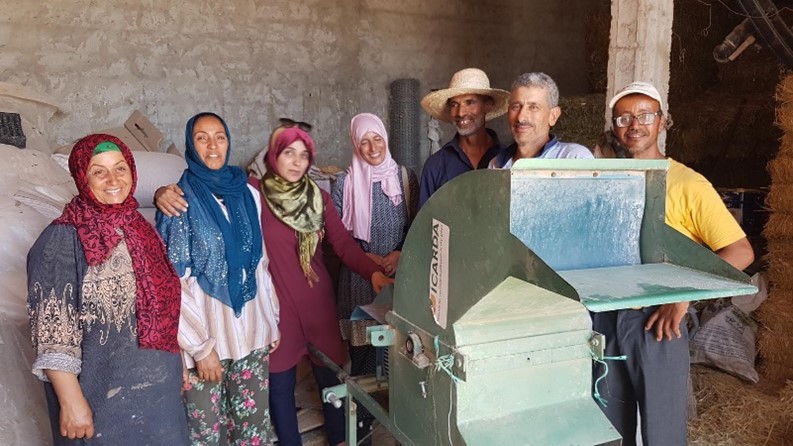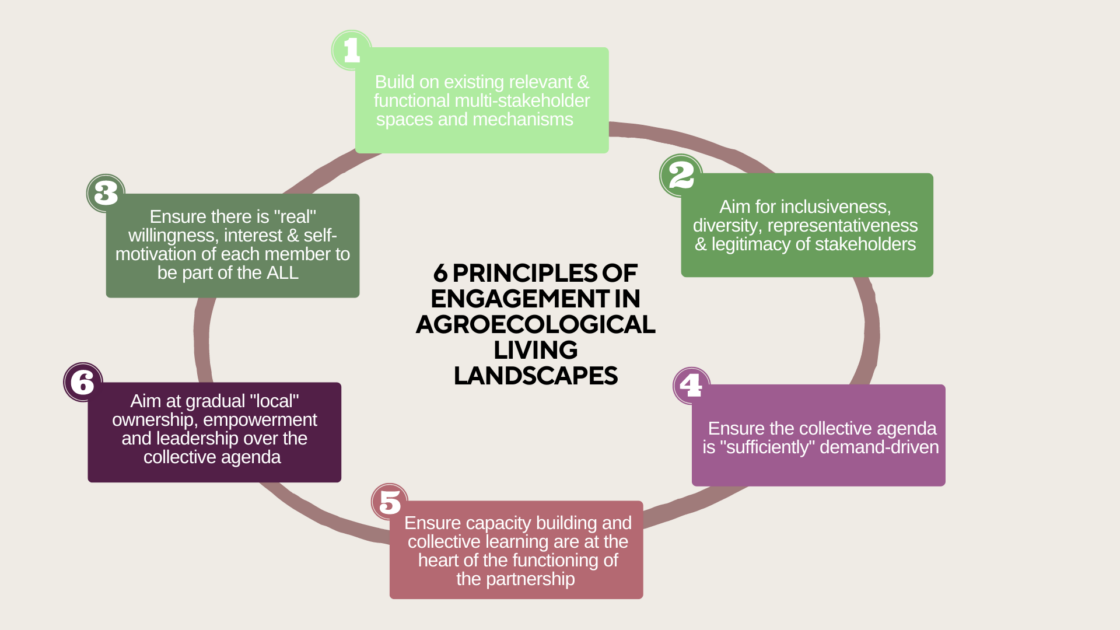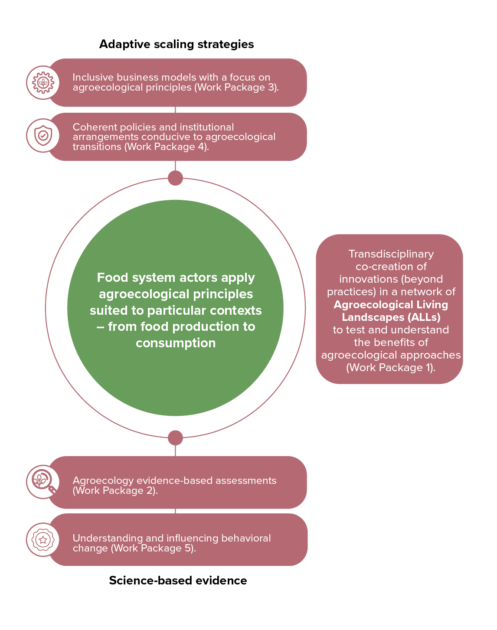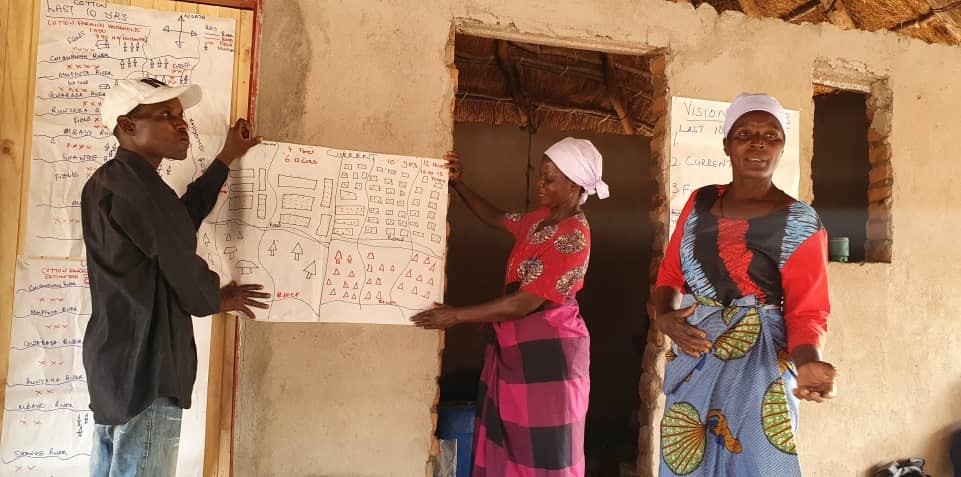Engaging with stakeholders and establishing Agroecological Living Landscapes: Overall reflections
-
From
CGIAR Initiative on Agroecology
-
Published on
31.12.22
- Impact Area

Authors: Bernard Triomphe and Nadia Bergamini, Work Package 1 coordination, with inputs from country teams and country WP1 leaders
| This blog presents a reflection about the early challenges faced with stakeholder engagement and ALL establishment. See full report on ALL establishment |
Introduction
The Agroecology Initiative has put at the very center of its work plan the formation of Agroecology Living Landscapes (ALLs), which are intended to be territories for multi-stakeholder engagement in which agroecological innovations can be identified, codesigned, tested and adopted by its members. Established ALLs are expected to achieve a genuine, realistic, and context-specific agroecological transition aligned with the 13 agroecological principles identified by the HLPE (2019).
In this Initiative, Work Package 1 (WP1) is responsible for the transdisciplinary co-creation of innovations in the ALLs. ALLs will operate across all Initiative work packages dealing with new agroecological production practices, value chain arrangements, business models, policy- and institutional-enabling environment, and behavioral change strategies. During the Initiative kick-off workshop in March 2022, participants agreed that the establishment of the ALLs could not be done following a standard methodology: but rather that different country situations, trajectories, and human resources should determine agroecological transition pathways and most suitable multistakeholder approaches. Also, the Initiative aims to let national and local partners have a significant say, hence it was decided to identify common engagement principles (See Figure 1 and the related guiding document) and methodological guidelines that each country team could flexibly use to shape and guide its approach and related actions.

Key activities implemented towards ALL establishments included stakeholder (STH) mapping, the assessment of existing multistakeholder initiatives, and, in some cases, implementation of the early phases of a visioning exercise. National and local multi-stakeholder events, review of existing documentation, semi-structured interviews and focus group discussions were used to varying degrees by each country. Agreements are now being negotiated with key national or local stakeholders in some countries (e.g. Tunisia, Kenya, Peru, Zimbabwe) to foster and clarify their active participation in the Initiative and in the decision-making regarding ALL identification and establishment.
The ALLs emerging so far vary in size and scale, stakeholder composition and previous agroecological trajectories, and are at various degrees of formalization.
Kenya developed quite a sophisticated stepwise and careful process to identify potential ALL partners and engage with them. Zimbabwe progressed rapidly and held in quick succession national workshops to create awareness and validate choices, followed by local (ALL-level) workshops. Laos, and to a certain extent, India, had first to constitute their teams and mobilize the necessary human resources to get the ALL establishment process going. In India, AE dynamics are well advanced as a result of the state-wide Natural Farming program implemented since 2016. Tunisia and Burkina Faso have gone forward with confirming ALLs and inviting members to join even without having completed STH mapping. This in part reflects the project team’s existing knowledge and experiences engaging with a diversity of stakeholders in the framework of previous projects with similar or related objectives and approaches. To avoid the risk of drawing a too narrow set of previously known stakeholders, country teams will complete the stakeholder mapping exercise, allowing them to remain open to the possibility of inviting “new” stakeholders to join. Burkina Faso could not yet implement ALL-level workshops as a result of political turmoil and security concerns in the second half of 2022.
Stakeholders engaged in emerging ALLs
A rather large number of stakeholders were identified in each country during stakeholder mapping and a total of 1.346 individual Food System Actors (FSA) have been engaged to date across the 7 countries (see blog on Food System actors engaged). Logically, the number of members who did integrate formally with the ALL or will do so in the near future is more limited (Table 1).
Table 1: Comparison between 7 countries in terms of stakeholders involved and physicality of the ALLs
| Country | Main stakeholders of the ALL | Physicality of the ALL |
| Peru | Farmer organization: Cocoa cooperative and its linked NGO, Research: National Institute of Agrarian Innovation (INIA), Regional Government of Ucayali (GOREU) | Small territory within an official admin unit, which coincides with the area of the influence of the Cocoa Cooperative. Selecting a meeting place for ALL activities is pending |
| India | Small and marginal farmers, especially women farmer, Women Self Help Groups (SHGs) and their federations, Public technical services | ALLs have been defined based on soil type, cropping systems, adoption rates of natural farming. Meetings take place in the offices of SHGs and in the Natural farming shops |
| Tunisia | Farmer organizations, national agricultural research and extension systems (NARES), Training and extension agencies, Local NGOs, Private sector | The ALL forms a transect along a physical and socio-territorial gradient touching two admin units and including 4 farmer organizations. Meetings take place in the offices of the FOs |
| Burkina Faso | Milk value chain actors: multi-stakeholder Dairy Innovation platform, R&D institutions, Public service actors, Producers’ organizations, NGOs, | The ALL is delimited by the area where dairy value chain actors operate. The existing dairy innovation platform has infrastructure / staff
Note: Security concerns è decision NOT to establish an ALL on legume -cereal systems around Ouagadougou |
| Lao | Marginal farming & fishing households, Agricultural producer groups, Women and Youth Union members, Farmers’ networks, Partnering stakeholders, Local authorities, Research organizations, Private sector, Local/regional training centers | One ALL is established and two more identified along a common watershed, including 10 villages along the Xekong River
Collective action is catalyzed by common property resources |
| Kenya | Government, local administration, Learning institutions, NGOs, CBOs, Farmer groups, Private sector actors | The “Community of place” is delimited by the Food System actors around a convening host (Farmer Training Center) whose offices and experimental space provide a meeting place. |
| Zimbabwe | Farmers and farmers groups, Government technical services (AARDS), Technical service providers, Local authorities, Private sector | Four ward (administrative sub-district units) and the official development committees established at ward level provide the territory for ALL actions |
The following are the core stakeholder types that are represented in the ALLs in the 7 countries: Farmers organizations or grass root organizations, public technical services (extension in particular), national research organizations (usually through a local branch), local governments.
In some countries, relying on existing government supported multi-stakeholder mechanisms (e.g. District and sub-district level development committees in the case of Zimbabwe or existing innovation platforms in Burkina Faso) is considered a good way of ensuring that the ALL can be sustainable beyond the life of the Initiative.
Less systematically represented are the following stakeholder types: NGOs, private sector, universities, consumers.
Several country teams consider that they should still map private sector stakeholders more explicitly and establish clear criteria for involving them in the ALL. The type of stakeholders from the private sector to involve will very much depend on the kind of markets the Initiative will be trying to link farmers to: for example, local versus export, or poor consumers versus rich ones. In Kenya, linking farmers with local organic markets seems relevant, whereas in Peru, the entry point for the time being is the EU export market. In Laos, there is an export market to China for quality rice, but this happens in a context of high food insecurity and intentions to expand to EU markets. In Zimbabwe, the target seems to be local markets.
Key factors of success for stakeholder engagement and ALL establishment
Based on results obtained and challenges the countries have faced, the following cross-country and partly overlapping considerations seem relevant:
Choosing the right partners for the Initiative and for formalizing ALLs
While ALLs are focused at the territorial scale, it makes sense to involve partners from national to local levels considering that the overall objectives of the Initiative are to impact food systems at these various scales.
As reflected in Engagement Principle 1, building on existing relationships with stakeholders involved in previous projects is a good entry point for ALL establishment as it provides a basis for trust between country teams and a host of stakeholders. The same can be said about taking advantage of existing multistakeholder mechanisms to avoid “reinventing the wheel”: this is for example the case in Burkina Faso where a dairy Innovation platform constitutes the core of the proposed ALL.
Also, past projects, pre-existing innovation platforms and previously tested technologies provide concrete input for engaging in innovation development: this is well illustrated by the design of on-farm experiments on technological production practices that is already taking place in Zimbabwe and Tunisia, despite the short time they had to codesign such experiments.
While stakeholder mapping reveals the existence of many actors in each territory, following our six engagement principles and furthermore the recommendation to start with a few “strong” partners and gradually enlarge the membership, not all “territorial” stakeholders will be formally part of the ALL. A challenge however is to reach out beyond those partners already onboard or already motivated by agroecology and to engage with those who are yet to be convinced yet may have a high influence in the outcomes pursued by the Initiative.
Defining the boundaries of the ALLs and deciding / assessing if and when an ALL formally exists?
As was discussed with country teams early on, defining ALL boundaries encompasses geographical and stakeholder dimensions. Different countries have chosen different boundaries: local administrative ones (ward in Zimbabwe, sub-districts in India); areas defined by the operation of a given value chain and its actors (dairy in Burkina) or the area of influence of farmer organizations (Tunisia’s GDA, but also India when zooming in on the village level, and to some extent, Peru), or around a core convening partner (cf. role expected to be played by NGO-operated training centers in Kenya, or by the Dairy Innovation Platform in Burkina).
When the core partner is an existing farmers’ organization, a question will soon arise about when and how to reach out to the apparently vast majority of farmers of the same area that are not part of these organizations? This is a key question for future scaling of innovations and other results.
At this early stage of ALL establishment in most countries, clarifying the criteria for considering when an ALL starts functioning “formally” is important– this includes clarifying what being an actual ALL member entails (does inviting an organization to an event automatically make it a member?). The same will apply to clarifying how an ALL will operate over time (facilitation, governance, work plan and budgets, M&E, roles, etc.). Doing so will also allow the Initiative to conduct in due time a comparative assessment of ALLs’ emergence and function across countries and clarify in a generic manner what an ALL actually is as a result of the adaptation of the concept to the context.
Note: How boundaries are being defined has significant implications for the sustainability of the ALLs. Clear steps are needed to make ALLs sustainable and less dependent on the country teams.
Dealing with the cross-WP and multiple stakeholder nature of ALLs
Establishing and operating ALLs is a dynamic and interdisciplinary process, which covers and involves different dimensions and issues that interact with each other (economic, biophysical, social). While the Initiative has a dedicated work package team at the forefront of ALL establishment, ALLs are the spaces where all initiative work packages interact, and where different types of innovation will soon be codesigned among ALL members.
More generally, country teams need to develop a strong collective thinking and understanding about what their ALLs are and how they are supposed to function to be able to implement WP specific activities in an articulated way, something that still strengthening in some countries. As each country team confirms who their core partners are national or ALL level, the views of such partners will have to be taken on board about what this enlarged team considers to be an ALL adapted to the national / local context, and how to go collectively about their establishment and functioning. This will be in line with (1) the engagement principles identified early on and (2) the stated intention of the Initiative to engage in codesign of innovation within the context of the ALLs.

Balancing process-based vs output-based issues within the Initiative
From the beginning, establishing ALLs has been identified as a key short-term output of the Initiative. Up to now, by conscious choice or by necessity, different approaches and paces have been followed depending on the countries and the specific context in which country teams operate. At the same time, unsurprisingly perhaps, the ALL-establishment process is time consuming in most countries: it will probably only be fully finalized by mid- to late 2023 rather than in late 2022 as was envisioned initially. The challenge hence is to proceed fast enough with ALL establishment to allow for an integrated and coherent implementation of all WPs, yet to respect the process and pace at which stakeholder engagement, codesign and co-leadership can actually take place, meaningfully and in a sustainable manner, which is very much country-specific.
Perspectives and next steps
At this juncture, all countries have been able to make the Agroecological Living Landscapes emerge even though ALL membership and governance are yet to be formalized. Also, a collective vision for agroecological transition needs to be developed at the ALL level. This means that, for the time being, the application of several of the 6 engagement principles is still partial, most notably with respect to principles 5 (ensuring there is a sufficiently demand-driven agenda) and 6 (ensuring co-leadership). This pace of progress reflects the fact that ALL establishment is a step-wise and iterative process, which cannot be decided during the course of a single kick-off event. It follows that some countries may still require a number of months to have their ALLs established and functional.
The next steps to be conducted in each country with respect to pursuing ALL establishment and formalization depend very much on progress that was achieved in 2022. For most countries, a priority is to conduct or finalize their stakeholder mapping, including finding a relevant visualization. Also, to develop the necessary analysis of mapping results to provide them with clear justification for engaging with stakeholders not presently known or considered, or to select which stakeholders to invite to become formal ALL members, and which ones to keep in mind for later. As said earlier, the objective of the stakeholder mapping exercise is not to produce visually attractive maps, databases and technical reports about stakeholder mapping: rather, it is to provide inputs for confirming ALL membership and refining stakeholder engagement.
Country teams will also engage in, or finalize, visioning with ALL members. Conducting this process requires giving attention to the diversity of views, objectives and desires of the different stakeholders. It is a crucial step to come up with a unified, shared vision and understanding among its members of what the ALL is all about and what an actual agroecological transition adapted to each context may entail. Describing a genuine shared vision will also contribute to developing a collective work plan, i.e. identifying the activities that each ALL agrees to implement over the 2023-2024 period, how they are to be implemented and who will be responsible for what in their implementation. This work plan may include activities that are possibly different from the activities formulated in the Initiative’s proposal, as they will respond to the needs and demands of ALL partners that have yet to be identified and negotiated. It is important to provide space for such adjustments, and this will reflect the very nature of the multistakeholder, codesign approach.
Lastly, country teams will soon need to engage in building the capacities of ALL stakeholders in the different dimensions and themes relevant for undergoing an agroecological transition and working in an ALL environment: technical capacities related to agroecology, codesign capacities, innovation capacities including functional capacities (capacity to interact with others, lobbying capacity, self-critical capacity), monitoring, evaluation and learning, etc.
For its part, WP1 coordination will continue to provide methodological support in terms of visioning, codesign and assessment of agroecological innovation. It will also support country teams to advance towards formalizing ALL membership and developing governance rules with ALL members. It will also foster a more detailed comparative assessment and understanding of the ALL establishment process which can hopefully form the basis for formal academic publications.

Related stories
Zimbabwe
Towards agroecological living Landscapes: First experiences from CIMMYT-Zimbabwe With coordination provided by the International Maize and Wheat Improvement Center (CIMMYT), the CGIAR Initiative on Agroecology builds Agroecological Living Landscapes in two territories with contrasting conditions and landscapes. In this video, farmers and partners in these territories share their expectations about diversifying agricultural production through a mixed farming approach and about enhancing their capacity to adapt to climate change.
Kenya
Learning how to ‘do engagement’ agroecology style: Insights into CGIAR’s Initiative’s on Agroecology ‘Engagement and Sustainability Planning’ Workshop to guide the implementing teams to be reflexive and self-aware in how they interact with stakeholders and partners and, by extension, how they implement the Initiative on the ground.
India
Can Agroecological Living Landscapes (ALLs) solve Food, Land and Water system challenges? Agroecology has gained momentum in recent years in India. Sites for the Agroecological Living Landscapes have been selected based on the presence of two typical soil types (red and black soil); proportion of farmers using natural farming methods; a variety of farmers who are at various stages of converting from conventional to natural farming methods; landless households; and cropping systems, including horticulture and agroforestry.
Number of Food System Actors engaged in the cocreation of agroecological innovations – Results of Year 1 engagement in seven countries At the current stage, food system actors are engaged in the creation of the Agroecological Living Landscapes, assessing contexts and envisioning possible agroecological transitions with stakeholders that will allow the codesign of agroecological innovations. The analysis of collected data on the total of 1,346 FSA who have been engaged to date in seven countries reveals valuable insights.
Related news
-

ICRISAT to Deliver World-Class Services as CGIAR’s Breeding Resources South Asia Hub
International Crops Research Institute for the Semi-Arid Tropics (ICRISAT)07.07.25-
Biodiversity
-
Food security
Strategic collaboration to scale innovation and deliver harmonized, high-quality support across CGIA…
Read more -
-

Reviving the earth: Soil health insights from Akole and Nandurbar, Maharashtra, India
The Alliance of Bioversity International and the International Center for Tropical Agriculture (CIAT)07.07.25-
Environmental health & biodiversity
In the pursuit of sustainable agriculture, soil is more than just dirt. It is a…
Read more -
-

Multifunctional Landscapes that reconcile food production, with ecosystem restoration and biodiversity conservation
Multifunctional Landscapes Science Program06.07.25-
Biodiversity
-
Environmental health & biodiversity
The CGIAR Multifunctional Landscapes Science Program (MFL SP) is driven by a bold vision of…
Read more -
